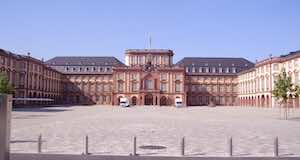Top > Musicians Related to C.P.E. Bach > Mannheim School
This site introduces unknown composer Emanuel Bach (C. P. E. Bach). This English version was translated from Japanese one by ChatGPT.
Mannheim School
The Mannheim School was a musical movement led by composers and performers based at the Mannheim Court in Germany during the mid-18th century. Their innovative orchestral techniques and compositional styles had a significant impact on the development of Classical music. The Mannheim Court Orchestra, at the center of this movement, was praised as “the finest orchestra in Europe” at the time.

Characteristics
1. Orchestral Innovations
The Mannheim School contributed to the technical and expressive advancement of the orchestra. In particular, their dramatic use of dynamics and unison passages stood out.
- Mannheim Crescendo: A gradual increase in volume.
- Mannheim Rocket: A rapid ascending arpeggio for dramatic effect.
2. Development of Musical Forms
They played a vital role in the establishment of sonata form in symphonies and instrumental works. Especially notable were the tonal contrasts and thematic developments in the first movements.
3. Emphasis on Expression
Their music was characterized by the pursuit of diverse emotions and delicate nuances, influenced by the Empfindsamer Stil (sensitive style).
Key Composers
1. Johann Stamitz (1717–1757)
The founder of the Mannheim School, Stamitz was both a conductor and composer who advanced the symphonic form and laid the foundation for the Mannheim style.
2. Carl Stamitz (1745–1801)
Johann Stamitzʼs son, who composed symphonies and concertos, spreading the Mannheim style further.
3. Franz Xaver Richter (1709–1789)
Richter incorporated polyphonic traditions and explored diverse musical styles.
4. Christian Cannabich (1731–1798)
Known for his leadership of the orchestra, Cannabich supported the later development of the Mannheim School.
Historical Significance
1. Influence on Classical Music
The Mannheim School greatly influenced composers like Haydn and Mozart. Mozart was reportedly deeply impressed by their orchestral techniques during his visit to Mannheim.
2. Development of the Symphony
They standardized the four-movement symphonic structure and further developed the sonata form.
3. Expansion of the Orchestraʼs Role
They established the orchestra as an independent expressive medium, laying the groundwork for Romantic music in the 19th century.
Conclusion
The Mannheim School brought about significant changes in 18th-century musical culture through technical innovations and the pursuit of expressive depth. Their achievements were indispensable to the maturation of Classical music and the subsequent development of music history.
“Which composers influenced the Mannheim School?”
The composers of the Mannheim School were influenced by many preceding composers and musical trends. Active from the mid to late 18th century, they were especially known for incorporating innovative approaches to orchestration and dynamics. Below are the main figures and trends that influenced the Mannheim School composers.
Primary Influences
- Johann Stamitz (1717–1757):
- A central figure of the Mannheim School, Stamitz himself was influenced by several composers. Being Czech-born, he was exposed to Italian and French music, notably drawing influence from the following composers:
- Italian Opera Composers:
- Alessandro Scarlatti (1660–1725):
- An Italian opera composer who revolutionized the aria and opera form. His music influenced melodic beauty and expressive depth.
- Giovanni Battista Sammartini (1700–1775):
- As an early symphonist, Sammartini greatly influenced Stamitz and other composers. His symphonies were marked by clear structure and bright melodies.
- French Music:
- Jean-Philippe Rameau (1683–1764):
- A French composer known for his contributions to harmony theory. His music, with its intricate orchestration and elegant ornamentation, influenced the Mannheim style.
- German Instrumental Music:
- Carl Philipp Emanuel Bach (1714–1788):
- The son of J.S. Bach, C.P.E. Bach’s emotionally rich and improvisational music influenced the Mannheim School’s expressive dynamics.
- Central European Symphonists:
- Johann Christian Bach (1735–1782):
- The younger brother of C.P.E. Bach, also known as the “London Bach.” His light and clear melodies also impacted the Mannheim style.
Summary
The composers of the Mannheim School were influenced by various musical traditions from Italy, France, and Germany. They incorporated these elements into their own style, focusing particularly on innovations in orchestration and dynamics. This significantly influenced the later development of Classical music, establishing the Mannheim School as a crucial phase in the evolution of symphonic and orchestral music.